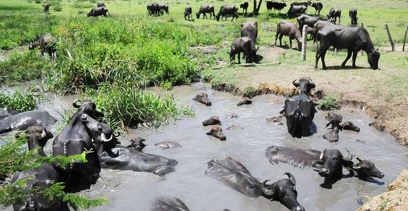 Guantanamo.- The new buffalo development program in the province, launched last year, is changing the dynamics of boosting this breeding, crucial for increasing meat and milk production, for the better.
Guantanamo.- The new buffalo development program in the province, launched last year, is changing the dynamics of boosting this breeding, crucial for increasing meat and milk production, for the better.
The creation of five new units and the incorporation of more municipalities into breeding cattle corroborate this previous opinion.
Of the raising areas for the buffalo set up, there are two in Niceto Pérez and there is one in Manuel Tames, El Salvador, and San Antonio del Sur, respectively. The latter still hasn’t received the animals, which should be received this June, according to Jorge Luis Mendoza Viñales, deputy delegate of livestock in Guantánamo.
Another significant boost to the program—extending until 2030—will have to be implemented on during this year, after the creation of new units as it is planned: three in Niceto Pérez (taking advantage of unused dairy farms), another in Manuel Tames, and the first in Maisí, where feasibility studies are being conducted.
According to Jorge Luis, the goal is to have 30 buffalo farms in the province by 2030, which have to produce 380 tons (t) of meat and 350,000 liters of milk. The increase, if achieved, will be significant, as the province currently produces around 40 tons in the first stage and has planned 110,000 liters of the latter this year.
Buffalo livestock holdings ranges milk or meat production, breeding, development of male or female buffalo, and breeding of oxen (the same as heifers in cattle ranching), as well as breeding of bulls, such as the one at the Iván Rodríguez Livestock Company, currently the only one in the territory.
Mendoza Viñales explains that the breeding units normally have 25 to 30 females and one male, and clarifies that there should be no more than one male, as this would lead to fighting among them for control of the yard, which could lead to injury or even death.
“If we include San Antonio del Sur, seven of the province’s 10 municipalities currently have buffalo units: Niceto Pérez (12), Manuel Tames (3), Baracoa (2), El Salvador (2), and Yateras and Guantánamo each, for a total of 22. In Maisí, as we mentioned, the site for the first one is being evaluated, with two candidate locations: La Tinta and El Cayo,” he said.
Imías and Caimanera are excluded from the program because they lack appropriate conditions for breeding, especially water, Mendoza Viñales asserts, adding that one of the main objectives, or line of work, is to increase the number of heads, primarily of breeding female